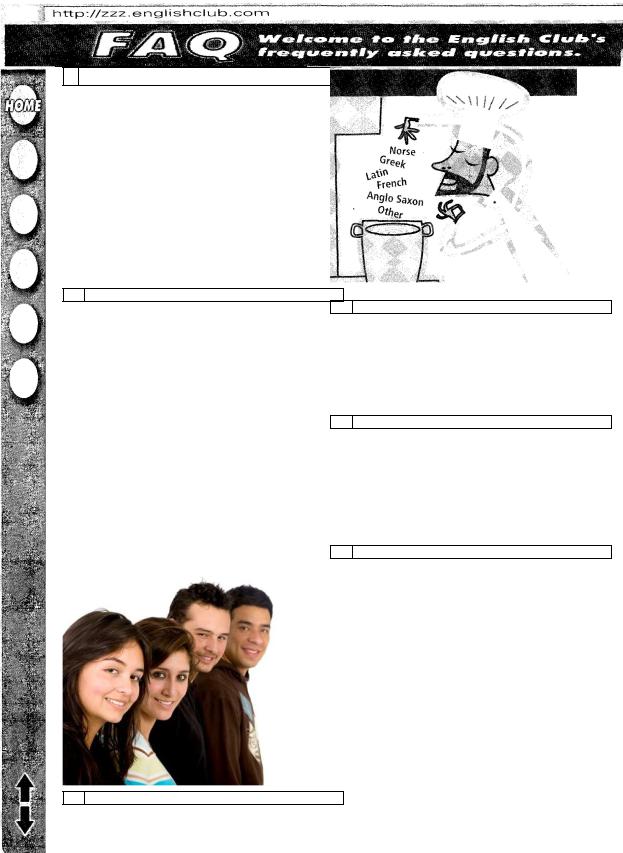
world_matters
.pdf
3g Complete these sentences using can, can’t where possible or (not) be able
to. |
|
|
|
|
|
|
|
|
|
|
|
|
|
|
|
|
|
1 |
I always learn a few words of the language when I go abroad. |
|
|
|
|
|
|||||||||||
It’s nice to |
|
speak to local people. |
|
|
|
|
|
|
|
|
|
|
|||||
2 |
I’m sorry, can |
you please repeat that? It’s very noisy and I |
|
hear you. |
|||||||||||||
3 |
I’m going to take extra French Lessons because I want to |
|
|
|
speak to people |
||||||||||||
when I’m on holiday. |
|
|
|
|
|
|
|
|
|
|
|||||||
4 |
It’s great using the Internet. |
|
|
|
|
|
|
|
|
|
|
||||||
You |
|
|
learn a lot of new expressions. |
|
|
|
|
|
|
|
|
|
|
||||
5 |
If |
you |
go to Australia for two years, you’ll |
|
speak English really well by |
||||||||||||
the time you come back. |
|
|
|
|
|
|
|
|
|
|
|||||||
6 |
Why don’t you ask your teacher to recommend a book? She may |
help |
|||||||||||||||
you. |
|
|
|
|
|
|
|
|
|
|
|
|
|
|
|
||
7 |
I’m very sorry, but I’m afraid that |
|
|
|
|
|
|
|
|
|
|
||||||
I |
|
|
|
come to the lesson next week. |
|
|
|
|
|
speak more than |
|||||||
8 |
People |
who work in the tourist industry usually need to |
|
||||||||||||||
just one language.
3h Write a list of five things that you can’t do at the moment but you will / might be able to do in the future. Use the ideas to help you. Find out what your partners think they will be able to do in the future.
Example
I can’t drive a car but I might be able to when I’m older.
read a novel in English / finish the coursebook
explain the difference between allow, let and permit / read EXTRA ACTIVITIES section
graduate from university / I am 20-22
visit the moon / technology becomes cheaper
4. Speaking
4a What questions would you ask about the English language?
Here are the most frequently asked ones. Match the questions with the answers from the webpage below:
Why do people learn English?
What’s the longest word in English?
How many people speak English?
How many words are there in English?
What’s the most common letter in English?
Where does English come from?
92

1
We can't answer that question exactly, but here's a recipe we came across the
other day. |
|
50 grammes |
Greek |
75 grammes |
Latin |
400 grammes |
Anglo Saxon |
150 grammes |
Norse |
300 grammes |
French (flavoured with |
Latin and Greek)
25 grammes other mixed languages Mix all the ingredients together. Cook slowly for 1,000 years
2
English is the main language in 30 countries, and there are about 375 million people who speak it as their first language. It is also used as an official language in over 70 other countries such as Cameroon, Tanzania, India, Pakistan, Malaysia and Fiji, and is a second language for about 350 million people. One in two Europeans can speak English quite well and can have a proper conversation, and in the future even more Europeans will be able to speak it. All in all, there are about 1,000 million (a billion) people who can't speak English, but they're learning it!
3
There are about 300,000 entries in the Oxford English Dictionary. However, there are many scientific and technical words that are not in the dictionary (for example, there are over a million types of insect). An educated English speaker only uses about 30,000 words.
4
According to the Oxford English Dictionary, it is the name for a lung disease caused by breathing in dangerous dust and is pneumonoultramicroscopicsilicovolcanoconios is
5
The letter 'e' is used more than any other. Ernest Wright was very interested in this fact, and wanted to see if it was possible to communicate without using this letter at all.
He wasn't able to write very much! In the end, he wrote a 200-page novel, Gadsby, without using any words containing the| letter 'e'. Sadly, it was not a great success, but here is a bit of it:
A glorious full moon sails across a sky without a cloud. A crisp night air has folks turning up coat collars and kids hopping up and down for warmth.
6
It's the top language for travel and tourism, and is used in business and science. At the moment, 80 per cent of the world's Internet sites are in English, but this will fall when more countries start using their own language.
93

4b With your partner discuss the following points: |
|
|
|
|
|
where the Russian language |
and festivals of Gaelic arts |
|
|||
comes from |
5 training teachers of Gaelic |
|
|||
how many people speak/learn |
|
|
|
|
|
Russian |
5c Listen again and choose the |
||||
why people abroad learn Russian |
correct word for each space. |
|
|||
what is the most frequently used |
1 It’s a Gaelic word meaning |
. |
|||
letter in Russian |
a ‘sea’ |
b ‘salmon’ |
c |
‘Celtic’ |
|
4c Work in groups. Write a sentence (as long as possible) without any words containing the letter ‘e’. Students whose sentence is the longest are the winners.
Make a list of the words containing more than ten letters.
4.d. Tell the class about Russian or any other language you know about. You can use FAQs from the webpage as a plan.
5. Listening
5a Work with a partner to discuss the following.
What languages are spoken in Scotland?
What can you do to prevent a language from disappearing?
 5b Listen to a radio interview with Bradana MacKinnon, spokesperson for the Society for the Promotion of Gaelic. Tick the things that are mentioned. Track 19.
5b Listen to a radio interview with Bradana MacKinnon, spokesperson for the Society for the Promotion of Gaelic. Tick the things that are mentioned. Track 19.
1statistics about people speaking Gaelic
2the differences between Gaelic
in Scotland and Ireland
3the economy of the Gaelic-speaking Community
4investment in cultural events
2 |
Should we fight to keep a dying |
||||
language |
|
|
, even if few people will |
||
ever use it or hear it? |
|
||||
a |
alive |
b spoken |
c life |
||
3 |
In the |
last 100 |
years or so, the |
||
number of Gaelic-only speakers in
Scotland |
has fallen |
from nearly |
to zero. |
|
|
a 4,400 |
b 44,000 |
c 34,000 |
4 It’s also true to say that since there has been a revival in the Celtic culture and language.
a the 1960s b the 1930s c the 1960s
5 There has been a huge in the
number of young children being educated in Gaelic in primary schools
and nurseries. |
|
|
a decrease |
b drop |
c increase |
6 At the moment we’re trying to raise our profile and we have a new fund-
raising |
|
. |
|
|
|
|
a |
|
program |
b |
campaign |
||
c company |
|
|
|
|
||
7 |
Every language, like every |
|
of |
|||
animal, is unique and worth protecting.
a species |
b spices |
c spaces |
|
5d Tell about your opinion on the problem of dying languages.
94

6. Extra Activities: Nonverbal Communication
Nonverbal Communication
Language plays a commanding role as a means of communication. When we communicate with other people, we use our facial expression, eye contact, body movement, intonation, volume of voice, clothing, body decoration, time, space and many other ways to transmit information. Such means of communication without words are called nonverbal communication. People had developed nonverbal communication skills long before they began to talk.
Some researchers are sure that nonverbal communication is more powerful than verbal communication. Ray Birdwhistell of the University of Pennsylvania has estimated that 30 or 35 percent of human communication occurs through words, the rest through nonverbal modes. The first scientific study of nonverbal communication was Charles Darwin’s book ‘The Expression of the Emotions in Man and Animals’ (1872). In this work Charles Darwin studied facial expression.
Nonverbal communication can be communicated through gesture and touch, by body language or posture, by facial expression and eye contact as well as through object communication such as hair-styles or even furniture. In other
words nonverbal communication can be considered ‘silent language’ which serves to express feelings without using words.
Nonverbal communication takes place simultaneously with verbal communication. For example, When we agree or disagree with somebody, we often nod or shake our head to convey positive or negative feelings. We can show a person that we are pleased with him or her or want to be friendly patting him or her on the shoulder. The words of love and affection are often accompanied by a hug or kiss.
Many aspects of nonverbal communication are greatly influenced by culture. People from different cultures interpret nonverbal behavior differently. For example, in Australia winking at women is improper; in Finland folding one’s arms shows arrogance and pride; In Greece waving is an insult.
Direct eye contact is a sign of respect and attention in America and Europe; whereas in some Asian countries downcast eyes are a sign of respect and attention. In many Asian cultures, the bow signifies the culture’s concern with status and rank. In Japan low posture is an indicator of respect. In the United States, where people are usually informal and friendly, Americans often fall into chairs or slouch when they stand. In Germany and Sweden, where people are more formal, slouching is a sign of rudeness and poor manners. In Ghana and in
95
Turkey, sitting one’s legs crossed is extremely offensive.
Proximity and touching behavior often convey attitudes of liking and affection in many cultures. Latin America and Southern Europeans use touching behavior frequently and have a closer distance for conversation. In Thailand, patting an adult on the head is offensive.
In different countries people have different ways of greeting each other. Arab men often greet by kissing on both cheeks. In Thailand people greet with both hands closed in front of chest. In Japan, men greet by bowing, and in the United States, people shake hands.
Even the high or low pitch of the tone and volume of the voice play a very important role in communication and bay be interpreted differently. Arabs speak very loudly to show strength and sincerity. Germans use a commanding tone to show authority and selfconfidence. In Japan, raising one’s voice often means a lack of self-control. For Japanese people a gentle and soft voice reflects good manners.
We should remember that what is acceptable in one culture may be completely unacceptable in another. For example, the ‘OK’ gesture in the American culture is a symbol for money in Japan. The same gesture is obscene in some Latin American countries; while
for Chinese or people in the South of France it is zero or nothing.
People’s nonverbal actions can say us much more than their words. For example, your partner wants to show you that he I calm. Relaxed and selfconfident, but his voice quavers and you notice his hands shake. That indicates that in reality this person is nervous and lacks confidence. Observing a person’s body language you can understand if he or she is telling the truth or lying. When someone tells a lie, he or she often makes many speech errors, hesitates, flushes or turns pale.
Physical appearance. Eye contact can show a variety of emotions such as warmth, disapproval, irritation, distrust, surprise, interest, attention, sadness and so on.
Good communication techniques in both verbal and nonverbal ways help you become a successful communicator. If we want to avoid breaks in communication and personal relationships, we should take into consideration cultural differences and behave in an appropriate way both verbally and nonverbally. If you observe a person’s gestures, posture, facial expression and movements, you will be able to catch the right information. Remember that a sincere smile and a friendly expression facilitate communication and help remove the barrier between interlocutors.
6a Read the following sentences and say if they are TRUE or FALSE:
1)People had developed nonverbal communication skills long before they began to talk.
2)Ray Birdwhistell of the University of Pennsylvania has estimated that 70 or 75 percent of human communication occurs through words.
3)Many aspects of nonverbal communications are greatly influenced by culture.
4)In Australia winking at women is a sign of admiration and respect.
96
5)In Finland folding one’s arms shows pensiveness and concentration
6)In some Asian countries direct eye contact is a sign of respect and attention.
7)In Ghana and in Turkey, sitting with one’s legs crossed is extremely offensive.
8)Arabs speak very loudly to show anger and irritation.
6b Complete each sentence (A-H) with one of the endings (1-8):
A.Nonverbal communication can be communicated through
B.Nonverbal communication takes place
C.In Greece waving is
D.In many Asian cultures, the bow signifies
E.In German and Sweden slouching is a sign of
F.Latin Americans and Southern Europeans use touching behavior frequently and have
G.In Japan, raising one’s voice often means
H.Observing a person’s body language you can understand if
1.The culture’s concern with status and rank.
2.A lack of self-control.
3.Simultaneously with verbal communication.
4.Gesture and touch, by body language or posture, by facial expression and eye contact as well as through object communication such as hairstyles or even furniture.
5.An insult.
6.He or she is telling the truth or lying.
7.A closer distance for conversation
8.Rudeness and poor manners.
6c People often use ’silent language’ to show their emotions and to send messages without words. What nonverbal models will you use to show that you are
- |
In a hurry |
- |
Excited |
- |
Attentive |
- |
Tired |
- |
Surprised |
- |
Nervous |
- |
Angry |
- |
Friendly |
- |
Pleased |
- |
In low spirits |
- |
Unfriendly |
|
|
- |
Bored |
- |
Interested |
|
|
For example: When a person is in a hurry he can look at his watch repeatedly and fidget uneasily in his seat.
6d What may the following nonverbal messages indicate?
A person: nods his head; pats another person on the shoulder; shrugs his shoulders; places his index fingers to his lips; keeps silence; coughs slightly; waves his hand;
97
stares fixedly at another person; raises his voice; stammers; covers his face with his hands; smiles a lot.
6e Answer the questions
1)What ways do we use to transmit information besides language?
2)Why do many researchers believe that nonverbal communication is more powerful than verbal communication?
3)What is the communication between nonverbal communication and a person’s culture?
4)How do people greet each other in different countries? How do they greet each other in your country?
5)What role do the high or low pitch of the tone and volume of the voice play in communication?
6)What can the ‘OK’ gesture mean in different countries?
7)Why does physical appearance play a very important role in communication?
8)Why is useful to develop good communicative techniques?
9)What should you do to avoid breaks in communication and personal relationships?
10)How can you facilitate communication?
6f Read and translate the quotations below. Choose any statement and comment on it
o ‘A warm smile is the universal Language of kindness ’. (William A. Ward)
o‘Communication means common understanding, a common tradition, common ideas, and common ideals.’ (Robert M. Hutchins)
o‘Communication is a skill that you can learn. It’s like riding a bicycle or typing. If you’re willing to work at it, you can rapidly improve the quality of every part
of your life’ (Brian Tracy)
o‘Effective communication is 20% what you and 80% how you feel about what you know’. (Jim Rohn)
o ‘Language is a social art’. (Willard Van Orman Quine)
98

7. Writing
Personal letters
7a Match the functions in column A with the phrases in column B. |
|
|||||
1 |
A |
A |
Dear + first name, |
|
B |
|
Asking about them |
|
|
|
|||
2 |
Giving news |
B |
Hi! How are things? |
How are you? |
How’s it |
|
|
|
|
going? |
|
|
|
3 |
Making suggestions |
C |
Great news about … |
Glad to hear that … Sorry to |
||
|
|
|
hear about … |
|
|
|
4 |
Name |
D |
Listen, did I tell you about … You’ll never believe |
|||
|
|
|
what … Oh, and another thing. |
|
||
5 |
Referring to their news |
E |
Why don’t you … ? |
Maybe you could … How |
||
|
|
|
about …? |
|
|
|
6 |
Signing off |
F |
Well, got to go now. |
Give my love to … |
Say hello |
|
|
|
|
to … See you soon! |
|
|
|
7 |
Closing expressions |
G |
Love, |
Lots of love, |
Yours, |
|
8 |
Greeting |
H |
Your first name |
|
|
|
7b You have received a letter from your English-speaking friend Julie who writes:
Hello Petya!
How are you? How are your English lessons going?
I started studying a foreign language this year at the university. It's pretty challenging for me. It took us a long time to learn to read and pronounce sentences with correct Russian intonation. I've gotten better at it, but it isn't easy. There are new challenges, such as conjugating verbs and declining nouns. It's crazy! Would you be able to help me? Could you give me any tips on how to handle these challenges?
Yours,
Julie
Write a letter to Julie (100-140 words). In your letter: answer her questions,
ask at least 3 questions about learning languages in her university/country.
99

Unit 9
Customs and Traditions
In this module you will:
Read about traditional festivals in different countries
Talk about parties
Test your knowledge about Scotland
Practise making suggestions and advice, asking for ideas, responding to suggestions, congratulating
Listen to a programme about April Fool’s Day
Write theses to give an oral presentation
Learn how Christmas is celebrated in different countries
Useful vocabulary:
Nouns |
festival, dance show, music concert, championship, parade, |
|
celebration, bonfire, firework, feast, going-away party, reception, |
|
parade, barbecue, fancy dress party, house-warming party, sit- |
|
down meal, hot drinks, snacks, soft drinks, practical joke, event, |
Verbs |
competition |
take place, take part, celebrate, commemorate, |
|
Adjectives |
traditional, international, national, folk |
Phrases and |
to dress casually/smartly, to wear formal/casual clothes, to bring a |
collocations |
drink, to give presents, to listen to/make speeches, to play music, |
|
to sing songs, to join in the fun, all over the world, to play a |
|
joke/trick on sb, to be taken in by |
100

1. Lead-in
1a Read about the water festivals and match the photos A-C with the festivals 1-3.
1. The Songkran Water Festival A
This festival is the start of the Thai New Year in April. On day one, Thais clean their houses, visit temples with food and visit old relatives. Day two is the famous ‘water-throwing day’ when people throw water at each other. No one is safe – not even police officers! On day three, there are dance shows and music concerts.
2. The Abu Dhabi F1 Water Festival |
B |
This five-day festival in December is part |
|
of the World Powerboat Championship. |
|
There are a lot of races and competitions |
|
(powerboat, water ski jumping and jet ski) |
|
for international teams. The festival starts |
|
with big parade, there is a large show and |
|
there is a lot of international food. |
|
3. The Vilagarcia Water Festival |
C |
This festival takes place on August 16th in |
|
northern Spain. After a parade people in |
|
the houses throw water on the people in |
|
the streets. After this, there is a drum |
|
dance and then the people jump in the sea! |
|
1b Complete the table with information about the festivals.
Festival |
Month |
Days |
Activities |
Songkran |
|
|
|
|
|
|
|
|
|
|
|
2. Reading
Pre-reading activities
2a Look at the photos below. What do you know about Scotland? Work in pairs and try to answer these questions.
101
